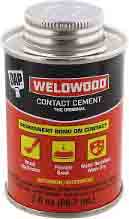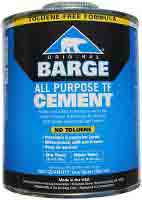There are two types of cement that are commonly used in home improvement projects – Barge Cement and Contact Cement. Both have their pros and cons, but which one is better for your project?
In this article, we will take a look at the differences between these two types of glue and go deep in comparison to help you decide which one is best for you.
The major difference between Barge and Contact cement is that Barge cement is glue-like and has a strong adhesive quality that makes it a popular mending, repairing, and resoling adhesive while Contact cement is a solvent-based bonding agent which appears in a watery form.
Barge cement is a good option for large projects, handcrafts, DIY projects, leathercraft, etc. It also has high durability due to its strong adhesive.
Contact cement is more powerful than barge cement and has a much longer shelf life. Due to the nature of contact cement, it is used for smaller joints of bonds.
What is Contact Cement

Contact cement is a brand of liquid rubber cement glue. It is used to glue glass to glass, glass to metal, and other surfaces that are not porous.
It is often used to replace broken glass in windows or to seal glass into structures.
It is often used to adhere tile to walls, ceramic or marble to tile, or bathroom fixtures to countertops. It is also commonly used to adhere electrical components to surfaces.
Contact cement (Buy on Amazon) is also used to bond copper pipe and copper tubing for plumbing.
Contact cement is also known as “no-wax” glue. It is a good alternative to silicone sealants. Its name comes from the fact that it is applied to two surfaces in contact with each other and dries to form a strong bond.
Contact cement is typically applied in liquid form and is then left to dry. Contact cement is considered a volatile substance; it contains hydrochloric acid and releases a solvent while evaporating. Contact cement is considered harmless when not in contact with skin.
What is Barge Cement

Barge All Purpose Original cement glue is a water-soluble, chemical-free adhesive that can be used on all types of materials including rubber, plastics, leather, and fabric.
This glue is chemical-free and EPA-registered. It is not recommended for wet surfaces or as a final sealant. This product holds up to heavy industrial use and is waterproof. It is available in a 4-ounce package.
Barge Cement glue (Buy on Amazon) is water-resistant, quick setting, and non-staining. It is recommended to use the glue in dry areas, and keep it out of direct sunlight in humid environments.
This type of cement is normally used for building levees, bridges, and other coastal structures because it dries quickly and does not leave a powdery residue.
Barge cement glue is a very slow-setting adhesive that can be used for underwater construction.
What are the similarities between Barge Cement and Contact Cement
The similarities between barge and contact cement are few:
- They are both used in modeling and bonding
- They are both liquid adhesives that dry quickly
- They are both used to seal seams on different household materials
- Barge and contact cement are both strong and versatile products used in construction and remodeling
One similarity between the two is that they both produce an adhesive film when applied. The barge is a liquid that is applied to the surfaces to be glued, whereas contact cement is a powder applied to the surfaces to be glued before the two are pressed together.
Both are clear and hard to see in daylight, are generally used for the same purposes, and dry without the need to wait the specified amount of time (barge and contact cement dry quickly).
Barge and contact cement are both used to seal seams on many different types of household materials predominantly wood, glass, leather, Cork, etc.
The use of barge or contact cement is a technique that is commonly seen with cabinetry, wooden furniture, leatherwork, and home repair.
Barge Cement and Contact Cement: Comparison
Barge and contact cement are both adhesive products that are used to bond multiple materials
Although they are similar in some ways, they each have their own advantages.
Barge cement is a water-based adhesive that is used to bond a variety of materials, including wood, glass, ceramics, and porcelain.
It is available in several different types, including extra quick, quick, and extra slow.
There are a few key differences between barge cement glue and contact cement glue when it comes to installation.
Contact cement glue is more forgiving, in that it can be repositioned more easily if needed before it sets. Barge cement glue is more durable and less likely to peel off over time.
Barge cement is a mixture of pigments, solvents, and cement paste in an oil-resist synthetic carrier binder.
Contact cement is coated with titanium dioxide which offers another level of protection by blocking out UV rays.
Barge cement glue is polymer-modified glue that sets when the material is submerged in water.
This type of glue does not require contact with a form before it sets, unlike contact cement which is only usable with forms in place.
The barge cement also works underwater, which is less time-consuming than the 8 hours it takes contact cement to cure.
Barge cement is much more efficient in underwater usage
Barge cement is always found in the industrial trade and construction sectors. It is a heavy-duty cement glue that lacks flexibility. It lasts up to 3 years, making it an incredibly long-lived product.
If you are looking for a cement product that will not be used frequently, this may be the better alternative.
Contact cement is not as durable as barge cement and doesn’t last as long.
Barge cement and contact cement are both used when the mortar needs to adhere to surfaces that have round surfaces.
Barge is water-soluble, comes in powder form, and is mixed with water. Contact cement is a liquid that comes in a bottle.
It has chemicals in it which make it adhere easier to the surface, but only one surface at any given time – so it must be used carefully.
Contact cement is used for bonding a porous and non porous material together while barge is used for sealing, waterproofing, etc
One other difference is that contact cement is used for bonding two materials together that are both porous and nonporous.
This makes them a good substitute for wood glue and steel or iron nails. Barge cement, on the other hand, is used for sealing, waterproofing, and binding. It is used when you need thick glue that won’t crack.
Barge cement is made of polymer or resin with a solvent, while Contact cement is made with linseed oil and turpentine
The barge cement is made up of a polymer or resin and a solvent, which are mixed and then usually sprayed on the surface that the barge cement is being applied.
After the barge cement has been applied it is usually let dry for a few moments and then usually the surfaces are rubbed together.
The contact cement however is often made from linseed oil and turpentine and the glue is applied to both surfaces that need to be joined together. After the surfaces have been joined together they are rubbed together and then left to dry.
Which is better and why?
Contact cement is better than Barge because it has a lower VOC (Volatile Organic Compounds) content and can also be used as glue.
Volatile organic compounds (VOCs) are naturally occurring carbon-based chemicals that are released into the air.
Many of these chemicals have been linked to negative health effects, and some have been linked to cancer. VOCs can also cause water pollution, so this gives contact cement a greater edge as a safer alternative.
Barge cement is able to bond material but is not considered solvent-resistant. Contact cement is a type of glue that can be used in woodworking, metalworking, construction, papermaking, and more.
Unlike barge, contact cement is usually a non-toxic, non-sensitizing adhesive.
Related:
This page may contain affiliate links.
To support the content and the knowledge I share here, I earn from qualifying purchases from Amazon at no extra cost to you.
